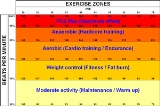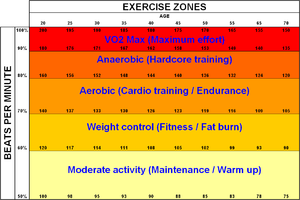
Anaerobic exercise
Encyclopedia

Lactic acid fermentation
Lactic acid fermentation is a biological process by which sugars such as glucose, fructose, and sucrose, are converted into cellular energy and the metabolic byproduct lactate. It is an anaerobic fermentation reaction that occurs in some bacteria and animal cells, such as muscle cells, in the...
. It is used by athletes in non-endurance
Endurance
Endurance is the ability for a human or animal to exert itself and remain active for a long period of time, as well as its ability to resist, withstand, recover from, and have immunity to trauma, wounds, or fatigue. In humans, it is usually used in aerobic or anaerobic exercise...
sports to promote strength, speed and power and by body builders to build muscle mass. Muscles energy systems trained using anaerobic exercise develop differently compared to aerobic exercise
Aerobic exercise
Aerobic exercise is physical exercise of relatively low intensity that depends primarily on the aerobic energy-generating process. Aerobic literally means "living in air", and refers to the use of oxygen to adequately meet energy demands during exercise via aerobic metabolism...
, leading to greater performance in short duration, high intensity activities, which last from mere seconds up to about 2 minutes. Any activity after about two minutes will have a large aerobic metabolic component.
Anaerobic metabolism, or anaerobic energy expenditure, is a natural part of whole-body metabolic energy expenditure. Fast twitch skeletal muscle (as compared to slow twitch muscle) operates using anaerobic metabolic systems, such that any recruitment of fast twitch muscle fibers will lead to increased anaerobic energy expenditure. Intense exercise lasting upwards of about four minutes (e.g., a mile race) may still have a considerable anaerobic energy expenditure component. Anaerobic energy expenditure is difficult to accurately quantify, although several reasonable methods to estimate the anaerobic component to exercise are available.
In contrast, aerobic exercise
Aerobic exercise
Aerobic exercise is physical exercise of relatively low intensity that depends primarily on the aerobic energy-generating process. Aerobic literally means "living in air", and refers to the use of oxygen to adequately meet energy demands during exercise via aerobic metabolism...
includes lower intensity activities performed for longer periods of time. Activities such as walking
Walking
Walking is one of the main gaits of locomotion among legged animals, and is typically slower than running and other gaits. Walking is defined by an 'inverted pendulum' gait in which the body vaults over the stiff limb or limbs with each step...
, running
Running
Running is a means of terrestrial locomotion allowing humans and other animals to move rapidly on foot. It is simply defined in athletics terms as a gait in which at regular points during the running cycle both feet are off the ground...
(including the training known as an interval workout), swimming, and cycling
Cycling
Cycling, also called bicycling or biking, is the use of bicycles for transport, recreation, or for sport. Persons engaged in cycling are cyclists or bicyclists...
require a great deal of oxygen to generate the energy needed for prolonged exercise (i.e., aerobic energy expenditure). In sports which require repeated short bursts of exercise however, it is the anaerobic system that enables muscles to recover for the next burst. Therefore training for many sports demands that both energy producing systems be developed.
There are two types of anaerobic energy systems: 1) the high energy phosphates, ATP adenosine triphosphate
Adenosine triphosphate
Adenosine-5'-triphosphate is a multifunctional nucleoside triphosphate used in cells as a coenzyme. It is often called the "molecular unit of currency" of intracellular energy transfer. ATP transports chemical energy within cells for metabolism...
and CP creatine phosphate and, 2) anaerobic glycolysis
Glycolysis
Glycolysis is the metabolic pathway that converts glucose C6H12O6, into pyruvate, CH3COCOO− + H+...
. The high energy phosphates are stored in very limited quantities within muscle cells. Anaerobic glycolysis
Glycolysis
Glycolysis is the metabolic pathway that converts glucose C6H12O6, into pyruvate, CH3COCOO− + H+...
exclusively uses glucose (and glycogen) as a fuel in the absence of oxygen or more specifically, when ATP is needed at rates that exceed those provided by aerobic metabolism; the consequence of rapid glucose breakdown is the formation of lactic acid (more appropriately, lactate at biological pH levels). Physical activities that last up to about thirty seconds rely primarily on the former, ATP-PC phosphagen, system. Beyond this time both aerobic and anaerobic glycolytic metabolic systems begin to predominate. The by-product of anaerobic glycolysis, lactate, has traditionally thought to be detrimental to muscle function. However, this appears likely only when lactate levels are very high. In reality, many changes occur within and around muscle cells during intense exercise that can lead to fatigue, with elevated lactate levels being only one (fatigue, that is muscular failure, is a complex subject). Elevated muscle and blood lactate concentrations are a natural consequence of physical exertion, regardless of what form it takes: easy, moderate, hard or severe. The effectiveness of anaerobic activity can be improved through training.
Lactate threshold (LT) (or lactate inflection point (LIP))
The lactate threshold (LT) is the exercise intensity at which lactateLactate
Lactate may refer to:*The act of lactation*The conjugate base of lactic acid...
(more specifically, lactic acid
Lactic acid
Lactic acid, also known as milk acid, is a chemical compound that plays a role in various biochemical processes and was first isolated in 1780 by the Swedish chemist Carl Wilhelm Scheele. Lactic acid is a carboxylic acid with the chemical formula C3H6O3...
) starts to accumulate in the blood
Blood
Blood is a specialized bodily fluid in animals that delivers necessary substances such as nutrients and oxygen to the cells and transports metabolic waste products away from those same cells....
stream. The reason for the acidification of the blood at high exercise intensities is two-fold: the high rates of ATP hydrolysis
Hydrolysis
Hydrolysis is a chemical reaction during which molecules of water are split into hydrogen cations and hydroxide anions in the process of a chemical mechanism. It is the type of reaction that is used to break down certain polymers, especially those made by condensation polymerization...
in the muscle release hydrogen ions, as they are co-transported out of the muscle into the blood via the MCT—monocarboxylate transporter, and also bicarbonate stores in the blood begin to be used up. This happens when lactate is produced faster than it can be removed (metabolized
Metabolism
Metabolism is the set of chemical reactions that happen in the cells of living organisms to sustain life. These processes allow organisms to grow and reproduce, maintain their structures, and respond to their environments. Metabolism is usually divided into two categories...
). This point is sometimes referred to as the anaerobic threshold (AT), or the onset of blood lactate accumulation (OBLA). When exercising below the LT intensity any lactate produced by the muscle
Muscle
Muscle is a contractile tissue of animals and is derived from the mesodermal layer of embryonic germ cells. Muscle cells contain contractile filaments that move past each other and change the size of the cell. They are classified as skeletal, cardiac, or smooth muscles. Their function is to...
s is removed by the body without it building up.
The lactate threshold is a useful measure for deciding exercise intensity for training and racing in endurance sports (e.g. long distance running, cycling, rowing, swimming and cross country skiing), but varies between individuals and can be increased with training. Interval training
Interval training
Interval training is a type of physical training that involves bursts of high-intensity work interspersed with periods of low-intensity work...
takes advantage of the body being able to temporarily exceed the lactate threshold, and then recover (reduce blood-lactate) while operating below the threshold and while still doing physical activity. Fartlek
Fartlek
Fartlek, which means "speed play" in Swedish, is a form of interval training which puts stress on the whole aerobic energy system due to the continuous nature of the exercise. The difference between this type of training and continuous training is that the intensity or speed of the exercise varies,...
and interval training are similar, the main difference being the structure of the exercise. Interval training can take the form of many different types of exercise and should closely replicate the movements found in the sport.
Accurately measuring the lactate threshold involves taking blood samples (normally a pinprick to the finger, earlobe or thumb) during a ramp test where the exercise intensity is progressively increased. Measuring the threshold can also be performed non-invasively using gas-exchange (Respiratory quotient
Respiratory quotient
The respiratory quotient , is a unitless number used in calculations of basal metabolic rate when estimated from carbon dioxide production. Such measurements, like measurements of oxygen uptake, are forms of indirect calorimetry...
) methods, which requires a metabolic cart to measure air inspired and expired.
Although the lactate threshold is defined as the point when lactic acid starts to accumulate, some testers approximate this by using the point at which lactate reaches a concentration
Concentration
In chemistry, concentration is defined as the abundance of a constituent divided by the total volume of a mixture. Four types can be distinguished: mass concentration, molar concentration, number concentration, and volume concentration...
of 4 mM (at rest it is around 1 mM).

